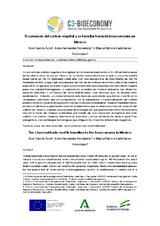Mostrar el registro sencillo del ítem
El comercio del carbón vegetal y su transitar hacia la bioeconomía en México
| dc.contributor.author | Carrillo Ávila, Noel | |
| dc.contributor.author | Hernández Hernández, Adan | |
| dc.contributor.author | Castellanos-Potenciano, Blanca Patricia | |
| dc.date.accessioned | 2022-10-17T15:43:35Z | |
| dc.date.available | 2022-10-17T15:43:35Z | |
| dc.date.issued | 2021 | |
| dc.identifier.issn | 2660-9126 | |
| dc.identifier.uri | http://hdl.handle.net/10396/24140 | |
| dc.description.abstract | El consumo de carbón vegetal a nivel global se ha incrementado entre un 3 y 4% de forma anual en los últimos años. Su uso en México, es un factor socio-cultural por lo que su consumo podría llegar hasta las 700 mil toneladas cada año, con una perspectiva de crecimiento de 360 mil toneladas al 2030, lo que implicaría disponer de más de dos millones de metros cúbicos de madera para tal fin. En general, no existe un proceso estandarizado para la producción de carbón vegetal para una calidad homogénea, su elaboración se realiza de manera artesanal con diferentes especies forestales y en hornos de tierra rudimentarios, con técnicas que no brindan altos rendimientos. Además, su comercialización está llena de opacidades que limitan cuantificar los verdaderos volúmenes que se comercializan. Así, la elaboración y comercialización del carbón podría constituir una amenaza para el futuro de los recursos maderables. Dada esta problemática, el objetivo del texto es plantear la situación problemática que se observa entorno al comercio del carbón en México y expone la necesidad de investigación que permita transitar en la economía circular a través del manejo sustentable, por medio de una conversión energética alta (más carbón con menos madera), plantaciones exprofeso y el uso eficiente de residuos para fines energéticos, con estrategias tecnológicas que mitiguen los impactos ambientales negativos. | es_ES |
| dc.description.abstract | Global charcoal consumption has increased between 3 and 4% annually in recent years. Its use in Mexico is a socio-cultural factor, so its consumption could reach up to 700 thousand tons each year, with a growth perspective of 360 thousand tons by 2030, which would imply having more than two million cubic meters. of wood for this purpose. In general, there is no standardized process for the production of charcoal for a homogeneous quality, its elaboration is carried out in a traditional way with different forest species and in rudimentary earth ovens, with techniques that do not provide high yields. In addition, its commercialization is full of opacities that limit the quantification of the true volumes that are commercialized. Thus, the processing and marketing of charcoal could constitute a threat to the future of timber resources. Given this problem, the objective of the text is to present the problematic situation that is observed around the coal trade in Mexico and exposes the need for research that allows moving in the circular economy through sustainable management, through high energy conversion (more coal with less wood), exprofeso plantations and the efficient use of waste for energy purposes, with technological strategies that mitigate negative environmental impacts | es_ES |
| dc.format.mimetype | application/pdf | es_ES |
| dc.language.iso | spa | es_ES |
| dc.publisher | Universidad de Córdoba, UCOPress | es_ES |
| dc.rights | https://creativecommons.org/licenses/by/3.0/ | es_ES |
| dc.source | C3-Bioeconomy 2-55-68( 2021) | es_ES |
| dc.subject | Recursos-forestales | es_ES |
| dc.subject | Economía-circular | es_ES |
| dc.subject | Sustentabilidad | es_ES |
| dc.subject | Forest-resources | es_ES |
| dc.subject | Circular-economy | es_ES |
| dc.subject | Sustainability | es_ES |
| dc.title | El comercio del carbón vegetal y su transitar hacia la bioeconomía en México | es_ES |
| dc.title.alternative | The charcoal trade and its transition to the bioeconomy in Mexico | es_ES |
| dc.title.alternative | 2021 | es_ES |
| dc.type | info:eu-repo/semantics/article | es_ES |
| dc.relation.publisherversion | https://www.uco.es/ucopress/ojs/index.php/bioeconomy/index | es_ES |
| dc.rights.accessRights | info:eu-repo/semantics/openAccess | es_ES |

